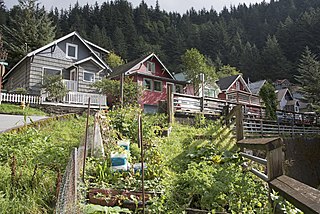Starr Hill is a populated place in Juneau, Alaska, United States. It is named for Frank Starr (1849-1898), a soldier from Maine who arrived shortly after the discovery of the Juneau gold fields in 1880, staked some claims but mainly found work in construction. Starr also staked land on the hill near the road leading to the Silver Bow Basin gold fields. The Hill saw significant development beginning in 1913 when Conrad Fries (d. 1922) built six miners’ cabins on the 500 block of Kennedy Street, buildings which are now listed on the National Register of Historic Places. A few years later Juneau businessman Bernard (B.M.) Behrends (b. 1862) built five smaller cabins on the 400 block of Kennedy. Starr Hill now includes several dozen private homes which overlook upper Juneau and the Alaska State Capitol, and a trailhead to the Mount Roberts Trail. [1]

The City and Borough of Juneau, commonly known as Juneau, is the capital city of Alaska. It is a unified municipality on Gastineau Channel in the Alaskan panhandle, and it is the second largest city in the United States by area. Juneau has been the capital of Alaska since 1906, when the government of what was the District of Alaska was moved from Sitka as dictated by the U.S. Congress in 1900. The municipality unified on July 1, 1970, when the city of Juneau merged with the city of Douglas and the surrounding Greater Juneau Borough to form the current municipality, which is larger by area than both Rhode Island and Delaware.

Alaska is a U.S. state in the northwest extremity of North America, just across the Bering Strait from Asia. The Canadian province of British Columbia and territory of Yukon border the state to the east, its most extreme western part is Attu Island, and it has a maritime border with Russia to the west across the Bering Strait. To the north are the Chukchi and Beaufort seas—southern parts of the Arctic Ocean. The Pacific Ocean lies to the south and southwest. It is the largest state in the United States by area and the seventh largest subnational division in the world. In addition, it is the 3rd least populous and the most sparsely populated of the 50 United States; nevertheless, it is by far the most populous territory located mostly north of the 60th parallel in North America: its population—estimated at 738,432 by the United States Census Bureau in 2015— is more than quadruple the combined populations of Northern Canada and Greenland. Approximately half of Alaska's residents live within the Anchorage metropolitan area. Alaska's economy is dominated by the fishing, natural gas, and oil industries, resources which it has in abundance. Military bases and tourism are also a significant part of the economy.

The United States of America (USA), commonly known as the United States or America, is a country composed of 50 states, a federal district, five major self-governing territories, and various possessions. At 3.8 million square miles, the United States is the world's third or fourth largest country by total area and is slightly smaller than the entire continent of Europe's 3.9 million square miles. With a population of over 327 million people, the U.S. is the third most populous country. The capital is Washington, D.C., and the largest city by population is New York. Forty-eight states and the capital's federal district are contiguous in North America between Canada and Mexico. The State of Alaska is in the northwest corner of North America, bordered by Canada to the east and across the Bering Strait from Russia to the west. The State of Hawaii is an archipelago in the mid-Pacific Ocean. The U.S. territories are scattered about the Pacific Ocean and the Caribbean Sea, stretching across nine official time zones. The extremely diverse geography, climate, and wildlife of the United States make it one of the world's 17 megadiverse countries.
The name was published in 1957 by R. N. DeArmond and entered into the Geographic Names Information System on July 12, 2000. [2]
Robert Neil "Bob" DeArmond was an American historian who specialized in the history of Alaska, especially the Alaska Panhandle. Throughout the 1970s and 1980s, DeArmond wrote several historical columns for southeast Alaska publications; these included Days of Yore, Gastineau Bygones, and News of the Gold Camp. He lived in Sitka, Alaska, and continued to write until his death.

The Geographic Names Information System (GNIS) is a database that contains name and locative information about more than two million physical and cultural features located throughout the United States of America and its territories. It is a type of gazetteer. GNIS was developed by the United States Geological Survey in cooperation with the United States Board on Geographic Names (BGN) to promote the standardization of feature names.












